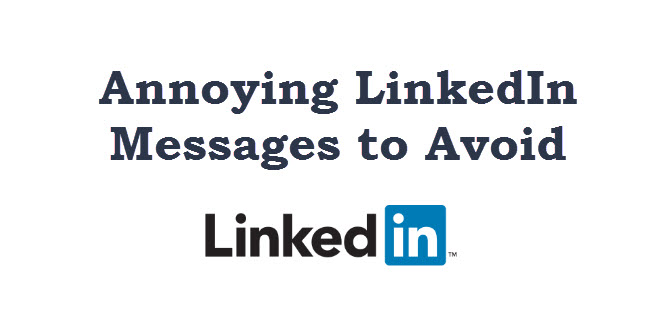
Many people spend a lot of time searching on LinkedIn. That’s what LinkedIn is for, right? We know when we put our profiles up that people will have the opportunity to contact us. We can limit who we connect with by turning off the InMail messaging function, restricting it only to introductions that are being made by people in our approved and trusted network. There are enough options available that we can’t really complain about people prospecting to us.
But, we can complain about the style people to use to connect with us. Whether it’s a recruiter searching for job candidates or a sales person attempting to sell new software to online businesses, most sales professionals would agree that the best way to start a potentially successful relationship over LinkedIn is by using a tailored and personalized approach. While there is no perfect method, a desirable approach is one which is direct, honest and clear, with the prospector describing who they are, who they work for and their reason for reaching out. Prospectors should make their message stand out and somehow entice or capture the attention of the recipient. Not as easy as it sounds, and some people make pretty bad mistakes!
Here’s a list of 5 irritating LinkedIn approach styles:
- The overly-friendly message
When some random person emails you on a busy day and asks how you’ve been, if the weather’s good and if you have any fun plans for the weekend, it can cause uncertainty that undermines the possibly good intention. InMails should be courteous and contain some pleasantries. But when it’s from someone we don’t know, it’s better if the message is more direct and open about why they’re getting in contact, without the small talk. A stranger asking about your wellbeing indicates that they want something from you, but might feel uncomfortable coming right out and asking for it.
- The cocky approach
And then there’s the message that contains some sort of weird, cocky attitude. Sales people sometimes attempt to get the upper hand in their LinkedIn message by making the recipient feel like they owe something to this random, unknown person. This approach sometimes focuses on the fact that ‘yes, it’s a generic approach’ but ‘I’m just doing my job’. Most of us don’t have time for this. While mass-sending emails is often a necessity for many sales people, refusing to take a personal approach and tailor the email to the recipient only emphasizes the sender’s laziness and lack of respect.
- The apologetic message
It’s not uncommon for people to receive a LinkedIn InMails from someone apologizing for contacting them out of the blue, before even mentioning why they are getting in touch. Someone who can honestly add value to a career or workplace shouldn’t feel the need to apologize. Positivity and directness is key. Apologizing gives the impression of having done something wrong or knowing that they are going to waste the recipient’s time.
- The daily message
There is a difference between being persistent and stalking. Sending the same message day after day after day is a perfect way to annoy someone. When receiving a text message, most people feel obliged to respond within a reasonable time frame, usually on the same day. With LinkedIn that time frame seems to be a bit longer and a sales person shouldn’t expect to receive a reply from their prospects immediately or on the same day. Persistence is admirable, but daily repetition is a different story.
- The sloppy message
As with any professional communication, receiving a message with bad grammar, misspelled names and sketchy auto-fill lines that get your name wrong is a major red flag.
So there you have it, the annoying LinkedIn messaging styles that can be exasperating to be on the receiving end of. You’ve probably noticed that there are no screenshots of real examples and no real names used. That’s because doing so would be unprofessional and unnecessary. Prospecting is part of many peoples’ jobs. Unless the message is threatening, spiteful or potentially dangerous, it’s often best to just ignore it. Or maybe you could tag them in this article! There’s no need to ruin someone’s career. Besides, they may wind up doing that themselves with their dubious prospecting methods!
